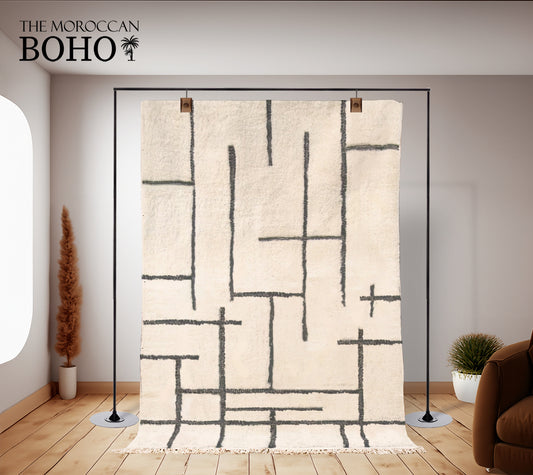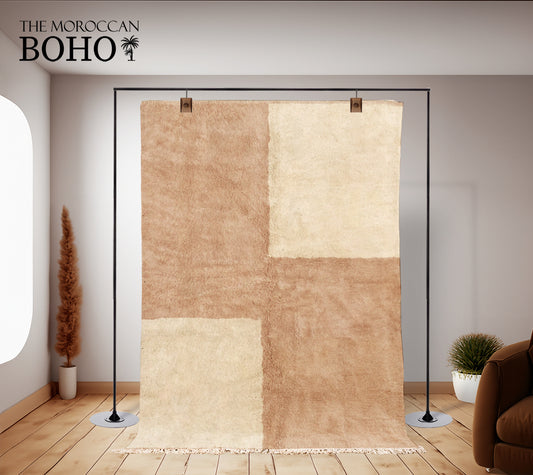
In the heart of every home that breathes character, you're likely to find a piece that whispers tales from afar. One such element that has found its way into the lexicon of global decor is the Moroccan rug. These handwoven marvels, which range from the minimalist appeal of the Beni Ourain to the vibrant kaleidoscope of the Boujad, embody a confluence of culture, history, and art. If you're on the hunt for a Moroccan rug, this guide is your compass to navigating the rich terrain of Moroccan weaves and finding the piece that resonates with the soul of your space.

Understanding the Moroccan Rug Tapestry
Before embarking on your journey, it's essential to recognize the distinct types of Moroccan rugs available. Each type hails from different regions and tribes, each carrying its own signature style:
- Beni Ourain: Cherished for their simple yet bold geometric patterns on a cream or white background.
- Azilal: Often lighter than Beni Ourain rugs, these are unique for their pops of color and abstract designs.
- Kilim (or Hanbel): Flat-woven carpets that are thinner and more lightweight than their pile rug relatives, often displaying colorful stripes and symbols.
- Boujad: Hailing from the Haouz region, these rugs are known for their rich hues and expressive designs.
- Boucherouite: Also known as 'rag rugs,' these crafty pieces are made from recycled fabric scraps, flaunting a riot of colors and textures.
- Taznakht: Usually more intricate and finely woven, often with a golden yellow or saffron tone.
Each rug tells a story — not merely through its patterns and colors but through its textures and techniques passed down generations.
A Tapestry of Selection
To discover the perfect Moroccan rug, your selection process should be woven with care, considering a variety of elements:
- Space and Size: Start by measuring the area where the rug will lay. In dining areas, ensure chairs still sit on the rug when pulled out. For living rooms, choose a size that either allows all furniture to sit on the rug or at least the front legs of sofas and chairs.
- Color and Pattern: Moroccan rugs can either accentuate your current palette or introduce a new spectrum of color. A Beni Ourain might complement a minimalist aesthetic, whereas a Boucherouite rug might bring joy to a more eclectic room. Consider the mood you wish to set: tranquil, energizing, or perhaps evocative?
- Texture and Comfort: The feel underfoot is just as critical as the visual appeal. High pile rugs like those from the Beni Ourain provide plush comfort, while Kilims offer a low-profile weave that's suitable for high-traffic areas.
- Artisanal Craftsmanship: Authenticity matters. Real Moroccan rugs are handcrafted, so opt for pieces that exhibit this level of craftsmanship for both quality and ethical procurement.
- Sustainability: Consider the material and process of creation. Wool from local sheep, natural dyes, and traditional weaving methods score high on sustainability and authenticity.

Harmonizing Aesthetics and Practicality
When integrating a Moroccan rug into your home, balance aesthetics with practicality:
- For a Cozy Ambiance: High pile rugs bring a snug quality to bedrooms and living rooms, especially in cooler climates or seasons.
- For Busy Areas: Sturdy and easy-to-clean rugs like Kilims are apt for entranceways and kitchens.
- For the Statement Makers: Choose a vivid Boujad or a Boucherouite rug to serve as a room's focal point, especially if your furniture and decor are understated.
- For the Minimalists: A simple yet luxurious Beni Ourain would complement a sparse, modern decor with sophistication.
Care and Longevity
The longevity of a Moroccan rug is intertwined with its care. Dust and debris should be shaken out periodically, especially for high pile rugs. Spills should be addressed immediately with gentle blotting. Professional cleaning every few years will maintain the rug's integrity. Bear in mind the specific care instructions based on the rug's material and weave.

Ethical and Authentic Acquisitions
The journey to selecting a Moroccan rug isn't just about finding a beautiful object: it's about making an ethical choice. Invest in rugs directly sourced from artisans or from reputable vendors who treat their crafters fairly. Authenticity isn't just a mark of quality; it's a celebration of the rug's cultural heritage.
Conclusion
Embarking on the quest for the perfect Moroccan rug is akin to weaving through the corridors of a Moroccan bazaar — every turn offers a fresh perspective, every alley holds a hidden gem. Your ultimate choice should not merely lie on the floor; it should lay claim to the ground of your individuality, comfort, and style.
As you drape this piece of Moroccan heritage within your home, remember that you are not just decorating a space, you’re crafting a sanctuary. The right rug will harmonize with your daily life, becoming not just a footnote, but a footnote in the co-authored story of your home and the loom. With thoughtful selection and a nod to sustainability and ethics, you'll not just purchase a decor piece — you'll invest in artisanal history and vibrant continuity.





